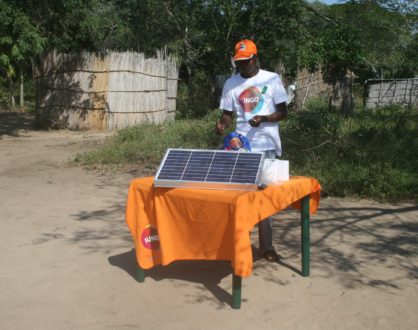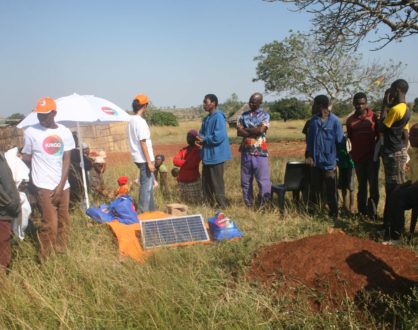IUNGO Project makes solar energy affordable to the low income population in sub-Saharan Africa countries without access to electricity through IUNGO solar charger.

Iungo



An unique “industrial” solar charger of AA batteries, mobile phones, haircut machines and other appliances that have a USB port and an innovative distribution model that assists potential entrepreneurs (with preference to women) to create their own business while providing energy to their community.
This way, IUNGO system has the clear purpose of minimizing the problem of lack of electricity in rural areas in a safe, affordable, versatile, reliable and income generation solution way. It not only avoids the prejudices that the actual solutions have, but also brings a highly positive socio-economic impact.
The users will then rent the IUNGO solar chargers to the selected entrepreneurs, who will pay, in return, a royalty by month, by day or by 2 hours service. By using IUNGO solar chargers, the entrepreneur will charge batteries, mobile phones and haircut machines. The entrepreneur will then sell to his community the services of battery charging, mobile charging (through the equipment USB port) and haircut or beard cut. Additional to the energy recharging system, we will distribute batteries and appliances to the entrepreneur so that he can also sell these to his clients. These appliances (LED lighting, flashlights, radios, AA to D Batteries’ adapters, emergency chargers, etc.) will work based on the AA batteries charged through the IUNGO solar charger.
When we compare this solution with the available alkaline batteries, we can identify positive outcomes from having rechargeable batteries which lower the cost per minute of power when comparing to actual disposable batteries, thus saving their income (44 k USD).
Since on the other hand more lighting and electricity for new appliances is consumed, the effect on the total energy expenditures can be affected. Appliances that will be most probably purchased and used are entertainment devices (radio) and mobile charging devices.
In parallel, 1505 entrepreneurs will have their own business: entrepreneurs will generate income with the mark-up of batteries and appliances and the services’ fee.
Regarding environmental issues, there are positive outcomes related to the reduction of kerosene consumption and related greenhouse gas emission avoided. Our estimation detailed in section O determines an amount of kerosene reduction during the 6 years of the project of 1 million liters and greenhouse gas emission avoided of 2 thousand tones.
We also estimate positive outcomes related to the reduction of waste whenever our batteries are re- used instead of the disposable batteries. Our estimation amounts to 55 thousand alkaline batteries.
Positive impact related to the hours spent on the energy source procurement such as batteries, kerosene and mobile charge is expected. For now the field results indicate one hour per week. This impact will be evaluated during the project as also his real benefits in terms of tasks performed in the time released.
Concerning the outcomes of this project, the fact that each kiosk has capacity to support in average 40 households with energy to basic services (light, mobile charging, radio…) and that we plan to implement 1505 systems, we are able to estimate that 54165 households, corresponding to 271k people, will benefit from this project.
At the household level, the most considerable benefit that can be expected in terms of lighting are the costs per hour that can drop by 60 percent if kerosene is substituted. We forecast annual saving per household of about $22.4, given that families can reduce their actual energy expenditures in lighting by switching to IUNGO (considering the monthly expenditures in kerosene by household).
The families will benefit from having this service available at low cost and with convenience avoiding long distances. Apart from kerosene also lighting resource savings can be expected due to the substitution of batteries for radio use.


